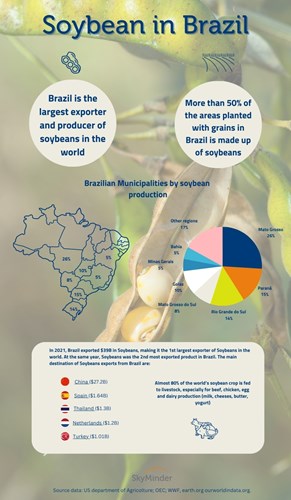Analysis and Studies - Products analysis
Soybean Market in Brazil: an insight
June 6th 2023
Soybean Market in Brazil
Soy is one of the most produced legumes worldwide which is native to Asia. In the last years, its production grew exponentially especially in countries in South America.
The market for soy is very important in the Latin American country of Brazil.
 One of the most common sources of protein in animal feed, soy is an oilseed that accounts for 56% of all the land cultivated with grains in Brazil (Conab 2020/21), and it is also becoming more and more popular in human cuisine. In light of population expansion, Brazil is regarded as one of the final untapped agricultural frontiers that can extend the area under cultivation and meet global demand. The production system depends on the growing of soy. It facilitates crop rotation, no-till farming on straw, biological nitrogen fixation, and soil nutrient recycling.
One of the most common sources of protein in animal feed, soy is an oilseed that accounts for 56% of all the land cultivated with grains in Brazil (Conab 2020/21), and it is also becoming more and more popular in human cuisine. In light of population expansion, Brazil is regarded as one of the final untapped agricultural frontiers that can extend the area under cultivation and meet global demand. The production system depends on the growing of soy. It facilitates crop rotation, no-till farming on straw, biological nitrogen fixation, and soil nutrient recycling.
Brazil was the world's top soy exporter in 2021, exporting $39 billion worth of soybeans. At the same year, Soybeans was the 2nd most exported product in Brazil. Brazil's top exporters of soybeans are China ($27.2 billion), Spain ($1.64 billion), Thailand ($1.3 billion), the Netherlands ($1.2 billion), and Turkey ($1.01 billion).
Brazil became the 25th-largest importer of soybeans in the world in 2021, bringing in $385M. Soybeans were Brazil's 113th most-imported product that year. Paraguay ($354M), Uruguay ($16.9M), the United States ($12.6M), Argentina ($934K), and Bolivia ($75.3K) are the main suppliers of soybeans to Brazil.
However, the always growing production of soybeans, especially in developing countries, is fueling the increase in pollution level and CO2 emissions. Indeed, 220,000 square kilometers of the Amazon and Cerrado biomes' forests were lost between 2006 and 2017, according to recent statistics from the Brazilian government's deforestation satellite monitoring system. Then, soy was grown on around 10% of the land, converting at least 21,000 square kilometers of original flora. Since soy is a product that only offers one yield per life cycle, fulfilling increased soy demand means planting more and more of it; as a result, this means using more and more land in a vast country. According to a study, the total area of land used to cultivate soybeans takes up the combined area of the Netherlands, Belgium, France and Germany, making it the second largest driver of deforestation after cattle rearing. (earth.org)
 Global soy production had a big increase in the past 50 years; indeed, according to many data, the global production of soy is 13 times higher than it was in the 1960s. Moreover, the production has more than doubled in the early 2000s. the USA has always been the main soybean producer and exporter up until 2018, when it was reached by Brazil. Already in the 1960s, the US were producing a lot of soy; hence its growth has been much slower than Brazil. Indeed, the latter did not reach the US’s level of output until 1990. ()
Global soy production had a big increase in the past 50 years; indeed, according to many data, the global production of soy is 13 times higher than it was in the 1960s. Moreover, the production has more than doubled in the early 2000s. the USA has always been the main soybean producer and exporter up until 2018, when it was reached by Brazil. Already in the 1960s, the US were producing a lot of soy; hence its growth has been much slower than Brazil. Indeed, the latter did not reach the US’s level of output until 1990. ()
Only a small percentage of global soybean production is destined for human consumption. Indeed, in 2018. Global soy production was divided into three categories of usage (direct human food, animal feed, and industrial processes), and final goods. More than one-third (37%) of the world's soybean produced is fed to poultry, one-fifth to pigs, and 6% to aquaculture. Only 2% of soy is used in the production of cattle and dairy products. As a result of this, almost 77% of the global production is destined to animals as a main source of food. On the other hand, with the rising plant-based diets within the general population, especially in developed countries, soybean is used as the main product substituting meat and dairy. However, unlike general thinking, only 7% of global demand is destined to direct human usage for producing tofu, soy milk, and other substitutes such as tempeh. Soy production is also used for industrial purposes. For instance, around 4% is used for biofuels, lubricants and other industrial processes.
